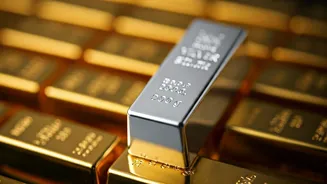Silver's Market Dynamics
Silver's performance is intricately linked to a complex interplay of supply and demand, industrial applications, and investment interest. Unlike gold,
which is primarily viewed as a safe-haven asset and a store of value, silver possesses a unique dual nature. It serves both as a precious metal and as a crucial industrial commodity. This blend of uses is a key factor influencing its price trajectory. The demand for silver in the industrial sector stems from its extensive use in electronics, solar panels, and other manufacturing processes. Concurrently, silver also benefits from investment demand, especially during times of economic uncertainty when investors seek safe-haven assets. Supply factors such as mining output, recycling rates, and government stockpiles further influence market prices. Therefore, understanding silver's performance requires analyzing its industrial demand and its appeal as an investment tool.
Silver vs Gold: Comparing
Comparing silver and gold reveals some key differences in their market behaviors. While both are precious metals, their responses to economic events often diverge. Gold is generally considered a safer bet during economic downturns, political instability, and inflation, often causing its price to rise. This is largely due to its established reputation as a reliable store of value. Silver, on the other hand, can exhibit higher volatility. Its price can fluctuate more dramatically in response to economic shifts. This volatility comes from silver's combined use as an industrial commodity. In periods of economic growth and rising industrial activity, silver demand and prices may increase. Meanwhile, a weakening economy could reduce industrial use, negatively impacting silver prices. Consequently, investors will view both as assets for different portfolio goals.
Industrial Demand Influence
The industrial demand for silver is a key driver of its price. As a highly conductive metal, silver is irreplaceable in several industrial applications. Its use in electronics, including smartphones, computers, and electric vehicles, significantly impacts the market. Moreover, the growing solar energy sector has fueled the demand for silver, as it is a critical component of solar panels. Increased manufacturing and technological advancements can heighten demand for silver, pushing its prices upward. Silver's indispensable role across various industries makes its price sensitive to shifts in manufacturing output, technology trends, and the broader economic landscape. The industrial demand is intertwined with technology and energy transitions, making it a critical factor to understand when assessing silver’s market dynamics.
Investment Demand's Role
Beyond industrial applications, investment demand also plays a significant role in shaping silver's price. Investors often view silver as an alternative to gold, especially when they believe silver is undervalued relative to gold. Economic uncertainties and inflationary pressures tend to increase the demand for both metals as investors seek safe-haven assets. When there are fears of inflation or a decline in the value of paper currencies, investors can turn to silver as a hedge. Factors such as geopolitical events, interest rate policies, and currency valuations can also impact silver investments. For example, if the dollar weakens or interest rates are lowered, silver can become more attractive. Investment demand is influenced by both the sentiment in the market and global economic conditions, so it is another critical factor in understanding silver's price.
Economic Indicators Impact
Economic indicators provide vital clues about silver's price movement. Key indicators to watch include inflation rates, which can spur demand as investors seek to protect their wealth. Interest rates also play a significant role: lower rates could boost the demand for silver and other precious metals. Changes in the dollar's strength also influence the market, as a weaker dollar makes silver cheaper for buyers. Moreover, industrial production data and manufacturing sector reports give insight into industrial demand, a main driver of silver consumption. Keeping an eye on these macroeconomic factors is vital for understanding the factors that can potentially drive silver prices higher. As economic conditions evolve, these indicators offer critical context for assessing silver's value and market potential.
Why Silver Shines?
Silver’s recent appeal is a result of the confluence of all the above-mentioned factors. The combination of strong industrial demand, particularly from sectors like solar energy and electronics, has created a base level of consumption that supports silver prices. At the same time, investment interest has increased. Investors looking for safe havens have contributed to the upward price. Furthermore, the economic outlook, including concerns about inflation, has added to the precious metal’s allure. Silver’s current shine isn't merely a fleeting market trend. Its performance reflects both its fundamental industrial utility and its enduring role as a store of value. Therefore, investors and market watchers would have to continue to monitor the market dynamics and economic indicators to stay ahead.

